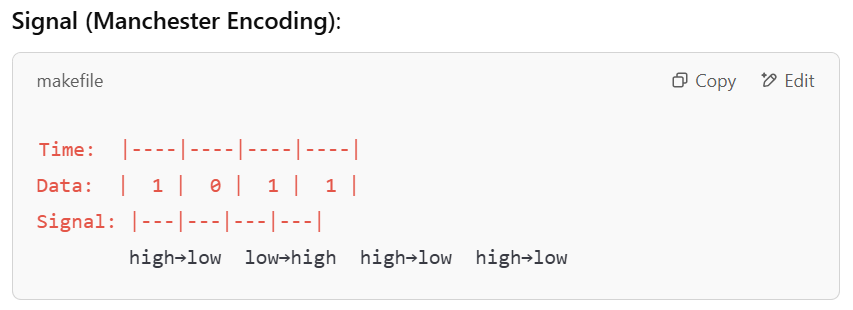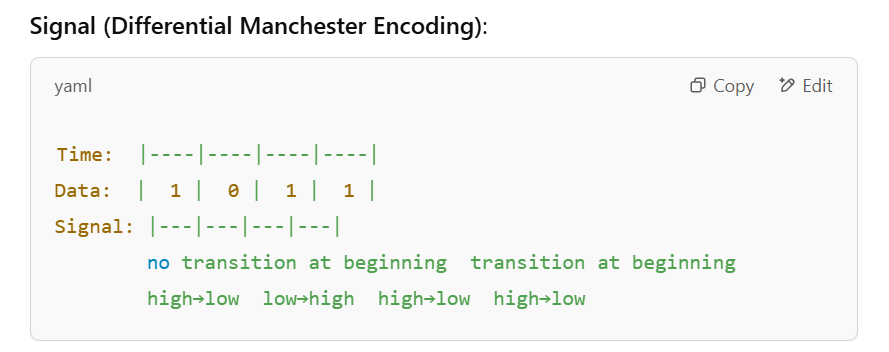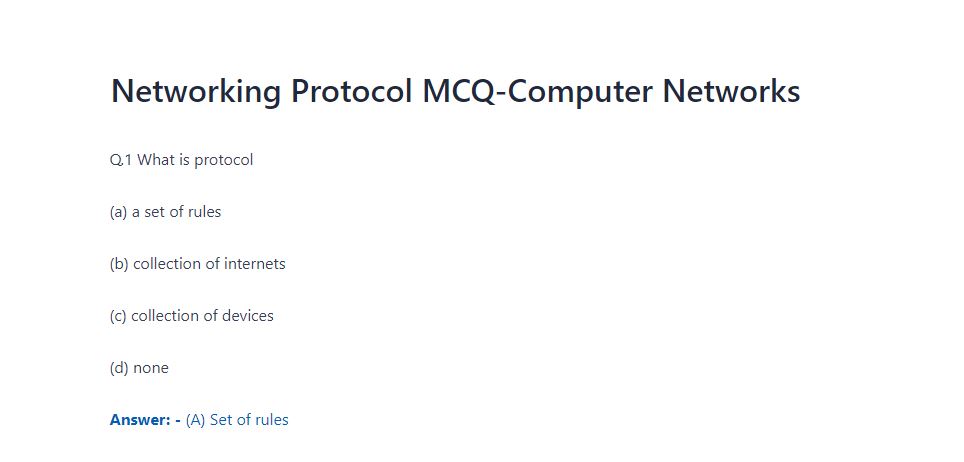Both Manchester Encoding and Differential Manchester Encoding are types of line coding techniques that are used to encode data for transmission over a medium, ensuring synchronization, and improving error detection. Although they both utilize transitions within each bit period to represent data, they have key differences in how these transitions occur.
1. Manchester Encoding
Manchester encoding is a method of encoding where a transition in the middle of each bit period is used to encode data. A bit is represented by the transition that occurs within the bit interval.
- Key Idea: Every bit (0 or 1) is represented by a transition in the middle of the time interval.
- Properties:
- 0: A low-to-high transition in the middle of the bit interval.
- 1: A high-to-low transition in the middle of the bit interval.
- The encoding always has a transition at the midpoint of every bit interval, making it self-clocking and synchronized.
Example:
- Data:
1 0 1 1 
- Advantages:
- Synchronization: Each bit period has a transition, making it easier to synchronize the sender and receiver.
- Error Detection: The presence of transitions makes error detection easier, as any missed or incorrect transition will be detected immediately.
- Disadvantages:
- Bandwidth Requirement: Since a transition occurs in every bit interval, Manchester encoding effectively doubles the required bandwidth compared to the original bit stream.
2. Differential Manchester Encoding
Differential Manchester Encoding, also known as Biphase Mark Code (BMC), is similar to Manchester encoding but differs in how transitions are used to represent binary data.
- Key Idea: The transition at the beginning of each bit interval is used to indicate the bit value, while the presence of a second transition in the middle of the bit interval (regardless of the bit value) helps with synchronization.
- Properties:
- 0: A transition at the beginning of the bit interval, followed by another transition in the middle of the bit interval.
- 1: A no transition at the beginning of the bit interval, but a transition occurs in the middle.
Example:
- Data:
1 0 1 1 -

- Advantages:
- No DC component: Differential Manchester encoding doesn’t produce a DC bias (unlike some other encoding methods).
- Error Detection: Like Manchester encoding, it allows for easy error detection.
- Disadvantages:
- More Complex: Differential Manchester encoding is more complex than Manchester encoding, as it requires a bit more processing to detect the presence or absence of transitions.
Key Differences Between Manchester and Differential Manchester Encoding
| Aspect | Manchester Encoding | Differential Manchester Encoding |
|---|---|---|
| Transition Point | Transition occurs in the middle of each bit interval. | Transition occurs at the beginning of the bit interval. |
| Bit Representation | A low-to-high transition represents 0, and a high-to-low transition represents 1. | A transition at the beginning of the bit interval represents 0, and no transition at the beginning represents 1. |
| Synchronization | Self-clocking (every bit has a transition). | Self-clocking (every bit has a transition in the middle). |
| Bandwidth Requirement | Higher bandwidth (due to a transition in the middle of each bit period). | Similar to Manchester encoding, but the transitions may appear differently. |
| Error Detection | Easy to detect errors because of the transitions. | Similar to Manchester, easy error detection via transition patterns. |
| Suitability for DC-free Transmission | Not suitable for DC-free transmission (contains DC component). | Suitable for DC-free transmission. |
| Complexity | Simple encoding and decoding process. | More complex, as the transition at the beginning must be considered. |
Conclusion
Both Manchester encoding and Differential Manchester encoding are widely used in computer networks to ensure proper data transmission and synchronization. The main difference between them lies in how transitions are used to encode data:
- Manchester encoding relies on a transition at the middle of each bit period, where both 1 and 0 are represented by specific transitions.
- Differential Manchester encoding uses a transition at the beginning of each bit period to signify a bit’s value, while the middle transition is used for synchronization.
In general, Manchester encoding is simpler and more commonly used for reliable data transmission, while Differential Manchester encoding is often chosen when DC-free transmission is desired.

